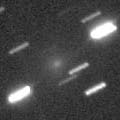
|
The condition is worst in this time, not visible in the Northern Hemisphere at all. It was observed in the Southern Hemisphere as 11.4 mag on June 6, as bright as expected (Michael Mattiazzo). However, in this appearance, the comet will never be observable again.
Date(TT) R.A. (2000) Decl. Delta r Elong. m1 Best Time(A, h)
July 1 5 41.03 22 36.1 1.465 0.531 13 8.6 3:03 (234, -9)
July 8 6 32.53 23 3.1 1.546 0.558 8 9.4 3:08 (230,-12)
|
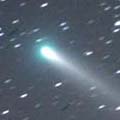
|
It reached to 6 mag at best in early May at the remarkable approach to the earth, when it became double naked eye comets with the component B around the zenith. Now it is going away from the earth and fading. It has already faded down to 7.8 mag (June 10, Willian Souza). But the apparent distance between the two components is reduced and two bright comets become to be in the same field. It still locates high in the Southern Hemisphere. But in the Northern Hemisphere, it locates extremely low in the morning in June. It will be getting higher gradually after July, however, it will be fading rapidly.
Date(TT) R.A. (2000) Decl. Delta r Elong. m1 Best Time(A, h)
July 1 2 0.18 -11 35.0 0.407 1.003 76 9.3 3:03 (294, 13)
July 8 2 9.58 -11 43.4 0.449 1.043 80 9.6 3:08 (298, 17)
|
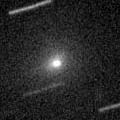
|
It brightened much more rapidly than expected after late April, and reached to 9.5 mag on June 15 (Willian Souza). Now it is 10.3 mag (Juny 28, Juan Jose Gonzalez). It will start fading after July. But it keeps observable in the evening until autumn when it becomes too faint to see. It keeps locating around 30 degree high. Great outburst over 6 mag has occured always in recent appearances in 1995 and 2001. So it may brighten much more after this.
Date(TT) R.A. (2000) Decl. Delta r Elong. m1 Best Time(A, h)
July 1 11 21.03 15 31.5 0.954 1.080 66 9.7 21:04 ( 89, 29)
July 8 11 53.73 12 24.6 0.951 1.106 68 9.9 21:02 ( 84, 29)
|
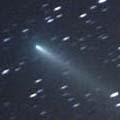
|
It reached to 5 mag at best in early May at the remarkable approach to the earth, when it became double naked eye comets with the component C around the zenith. Now it is going away from the earth and fading. It has already faded down to 8.5 mag (June 10, Willian Souza). But the apparent distance between the two components is reduced and two bright comets become to be in the same field. It still locates high in the Southern Hemisphere. But in the Northern Hemisphere, it locates extremely low in the morning in June. It will be getting higher gradually after July, however, it will be fading rapidly. Now it is a bit fainter than the component C. But it is still close to the sun. So another another outburst may occur due to the nuclear split.
Date(TT) R.A. (2000) Decl. Delta r Elong. m1 Best Time(A, h)
July 1 2 2.46 -12 9.1 0.386 0.998 76 10.0 3:03 (294, 12)
July 8 2 11.17 -12 21.2 0.429 1.037 80 10.5 3:08 (298, 16)
|

|
Now it is brightest and reached to 11.0 mag (June 15, Willian Souza). It keeps 11-12 mag until July. The condition is best beucase it is almost at opposition at the perihelion passage. However, it keeps very low, only about 15 degree high until September in the Northern Hemisphere. When it gets higher again, it will be fainter than 14 mag, too faint to see visually.
Date(TT) R.A. (2000) Decl. Delta r Elong. m1 Best Time(A, h)
July 1 19 39.73 -39 31.5 0.588 1.580 159 11.9 1:05 ( 0, 16)
July 8 19 39.32 -40 47.3 0.596 1.591 160 12.0 0:37 ( 0, 14)
|

|
It had been observed at 10 mag in the evening sky from winter to spring. But now it is not observable. It will appear in the morning sky again in late August at 13.5 mag. It will come to locate high in October, then it will be visible visually again at 14 mag.
Date(TT) R.A. (2000) Decl. Delta r Elong. m1 Best Time(A, h)
July 1 6 43.83 34 5.1 3.274 2.284 10 12.6 21:04 (143, -9)
July 8 7 1.08 33 40.7 3.338 2.349 11 12.7 3:08 (218, -8)
|
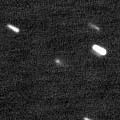
|
It was 15.0 mag on June 13 (Giovanni Sostero and Ernesto Guido), brightening as expected. It will be getting higher and brightening rapidly after this. It will become visible visually soon. It will reach to 8.5 mag from autumn to winter, and observable in its best condition. It keeps 14 mag still in 2007 April, so it keeps visible visually for a long time.
Date(TT) R.A. (2000) Decl. Delta r Elong. m1 Best Time(A, h)
July 1 0 15.15 9 8.7 1.836 2.127 91 13.3 3:03 (296, 46)
July 8 0 26.08 10 14.4 1.729 2.089 95 13.0 3:08 (300, 50)
|

|
New comet just discovered on June 14. It is bright as 13.4 mag and visible visually (June 16, Willian Souza). In the Northern Hemisphere, it locates rather low in the evening. In the Southern Hemisphere, it locates high. It will be observable at 13 mag for a long time after this.
Date(TT) R.A. (2000) Decl. Delta r Elong. m1 Best Time(A, h)
July 1 14 18.75 -28 16.1 1.929 2.612 121 13.1 21:04 ( 20, 24)
July 8 14 13.17 -24 20.5 1.984 2.561 113 13.1 21:02 ( 29, 25)
|

|
Now it is 12.8 mag (June 25, Carlos Labordena). Diffuse visually. It had been originally expected to reach to 9 mag at best. However, the brightness evolution had been very slow, and actually it is much fainter than originally expected. But with a large telescope, it is still bright and enjoyable. It will be observable in good condition after this until autumn. It will be visible bright as 12 mag for a while.
Date(TT) R.A. (2000) Decl. Delta r Elong. m1 Best Time(A, h)
July 1 16 12.40 31 32.8 1.845 2.455 115 13.3 21:33 ( 0, 87)
July 8 15 56.60 31 39.9 1.996 2.519 109 13.5 21:02 ( 36, 86)
|

|
It did not brighten so frequently in 2005. But it was often bright as 12-13 mag in early 2006. It is appearing again at dawn. It will be observable in good condition in autumn and winter.
Date(TT) R.A. (2000) Decl. Delta r Elong. m1 Best Time(A, h)
July 1 3 45.69 28 12.7 6.572 5.819 39 13.8 3:03 (245, 14)
July 8 3 51.02 28 33.1 6.502 5.821 44 13.8 3:08 (248, 20)
|

|
Peculiar asteroid moving along a comet-like orbit. It passes only 0.08 A.U. from the Sun on July 8. But it is not observable at that time. It will be fainter than 22 mag when it becomes observable.
Date(TT) R.A. (2000) Decl. Delta r Elong. m1 Best Time(A, h)
July 1 7 0.88 15 19.5 0.774 0.283 9 21.2 21:04 (129,-21)
July 8 7 0.39 24 52.1 1.117 0.114 2 13.8 3:08 (225,-15)
|

|
It has been visible at 13.5 mag since last October. Small and strongly condensed. It kept observable in good condition for a long time, but it will be getting lower in the evening, and will be too low to observe in July. However, it will be observable in good condition again at 14.5 mag in next winter.
Date(TT) R.A. (2000) Decl. Delta r Elong. m1 Best Time(A, h)
July 1 10 27.46 39 10.2 5.814 5.227 50 14.1 21:04 (119, 29)
July 8 10 34.05 38 9.3 5.881 5.234 46 14.1 21:02 (120, 26)
|
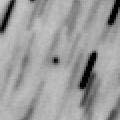
|
Recovered after 117 year blank since 1889. This time it will be closer to the earth than at the discovery. It moves northwards rapidly and keeps observable in good condition at 12-13 mag until September in the Northern Hemisphere. Based on the brightness in 1889, it can be much britghter than this ephemeris. However, because it is very close to the earth, it will look very diffuse. It was 15.0 mag on June 25 (Ernesto Guido and Giovanni Sostero), so it seems brighter than this ephemeris.
Date(TT) R.A. (2000) Decl. Delta r Elong. m1 Best Time(A, h)
July 1 17 31.42 -18 45.5 0.431 1.435 163 15.1 22:52 ( 0, 37)
July 8 17 20.30 -8 50.6 0.390 1.371 150 14.4 22:14 ( 0, 47)
|

|
Although it was not observed in its last return in 1999, it will be observable in good condition after the periheliion passage in this return. It will reach to 14.5 mag from June to August. Filip Fratev observed this comet on June 30, but it has not been announced officially yet. It was 18.6 mag, much fainter than this ephemeris.
Date(TT) R.A. (2000) Decl. Delta r Elong. m1 Best Time(A, h)
July 1 1 52.28 23 25.6 2.185 1.984 65 14.6 3:03 (264, 34)
July 8 2 4.57 25 59.8 2.130 1.990 68 14.6 3:08 (263, 39)
|

|
In 2005 spring, it reached to 14 mag and became visible visually as 13.8 mag (July 8, Reinder J. Bouma). In 2006, it will be the same condition and brightness in summer again. Somewhat low in the south. But it will reach to 14 mag.
Date(TT) R.A. (2000) Decl. Delta r Elong. m1 Best Time(A, h)
July 1 22 49.39 -19 15.9 2.524 3.182 121 15.1 3:03 (340, 33)
July 8 22 49.91 -19 36.4 2.459 3.192 128 15.0 3:08 (349, 35)
|

|
It has been lost since its discovery in 1986. The condition is good in this return. In calculation, it will be 14 mag from autumn to winter. However, it was probably in outburst and brightened unexpectedly at the discovery. So it can be much fainer than this ephemeris actually. In the Northern Hemisphere, it keeps observable until it fades out in next spring.
Date(TT) R.A. (2000) Decl. Delta r Elong. m1 Best Time(A, h)
July 1 17 51.51 -23 44.1 1.067 2.075 169 15.9 23:13 ( 0, 31)
July 8 17 43.63 -23 34.1 1.040 2.027 160 15.7 22:37 ( 0, 31)
|

|
It is outside of Jupiter's orbit, so it keeps observable for a long time. In 2006, it is still faint and locating somewhat low. But in 2007 and 2008, it is expected to be bright as 14.5-15 mag. It will locate high at that time, so it may be visible visually.
Date(TT) R.A. (2000) Decl. Delta r Elong. m1 Best Time(A, h)
July 1 19 47.16 -24 29.2 5.905 6.890 164 15.8 1:13 ( 0, 31)
July 8 19 40.14 -24 24.5 5.853 6.862 172 15.8 0:39 ( 0, 31)
|

|
Peculiar asteroid moving along a comet-like orbit. It will reach to 14 mag in next January. It keeps observable in good condition after this while getting brighter rapidly. It may turn to be a comet after this.
Date(TT) R.A. (2000) Decl. Delta r Elong. m1 Best Time(A, h)
July 1 22 50.28 5 11.7 2.082 2.644 112 16.6 3:03 (327, 56)
July 8 22 50.90 6 59.5 1.939 2.577 117 16.4 3:08 (339, 60)
|

|
It was fantastic, so bright as 3.5 mag, so large as 30 arcmin, locating high overhead at its best time in early 2004 January. Then it has been getting fainter gradually, and become already too faint to see visually. However, it is still bright as 15.8 mag by CCD observations (Mar. 30, Katsumi Yoshimoto). It keeps observable until October when it becomes fainter than 18 mag.
Date(TT) R.A. (2000) Decl. Delta r Elong. m1 Best Time(A, h)
July 1 16 11.70 2 10.0 5.378 6.151 136 16.5 21:34 ( 0, 57)
July 8 16 9.01 1 46.5 5.509 6.213 130 16.6 21:03 ( 0, 57)
|

|
It is unexpectedly bright as 15.5 mag on Apr. 2 (Ken-ichi Kadota). But it keeps very low until June. It will be getting higher after it starts fading. However, it has ever become a naked eye object in outburst, so observations are encouraged.
Date(TT) R.A. (2000) Decl. Delta r Elong. m1 Best Time(A, h)
July 1 0 16.54 -6 46.9 1.601 2.009 97 16.6 3:03 (310, 34)
July 8 0 23.75 -6 55.5 1.564 2.046 102 16.7 3:08 (316, 38)
|
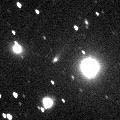
|
In 2005, it had been observed at 16 mag by CCD, or 14 mag visually, in spring and summer. It will be observable again at 16.5 mag in spring and summer in 2006. But the altitude will be somewhat lower than in 2005.
Date(TT) R.A. (2000) Decl. Delta r Elong. m1 Best Time(A, h)
July 1 19 11.37 -15 54.5 3.180 4.184 169 16.7 0:37 ( 0, 39)
July 8 19 4.43 -17 28.8 3.199 4.213 174 16.7 0:03 ( 0, 38)
|
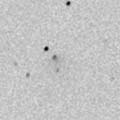
|
It is outside of Jupiter's orbit. So it keeps 16.5-17 mag for a long time. Because it moves in the northern sky, it keeps locating high and observable in good condition until 2006 summer.
Date(TT) R.A. (2000) Decl. Delta r Elong. m1 Best Time(A, h)
July 1 13 16.30 59 10.8 7.056 6.861 74 16.9 21:04 (147, 56)
July 8 13 16.14 57 49.3 7.110 6.867 72 16.9 21:02 (142, 54)
|

|
It was 16.0 mag on Mar. 13 (Ken-ichi Kadota). It kept 16-16.5 mag for about one year from early 2005. It keeps 17 mag until autumn when the condition becomes good.
Date(TT) R.A. (2000) Decl. Delta r Elong. m1 Best Time(A, h)
July 1 1 4.41 54 30.4 3.682 3.428 67 16.9 3:03 (225, 50)
July 8 1 6.83 54 32.1 3.629 3.452 71 16.9 3:08 (223, 54)
|

|
It is getting higher in the morning sky. It keeps observable at 17 mag in good condition after this until October.
Date(TT) R.A. (2000) Decl. Delta r Elong. m1 Best Time(A, h)
July 1 23 48.18 -10 25.5 1.977 2.455 105 17.1 3:03 (320, 35)
July 8 23 52.64 -9 41.0 1.914 2.468 110 17.0 3:08 (327, 39)
|

|
It was observed at 17 mag in 2005 summer. It will reach to 17 mag again in 2006 summer.
Date(TT) R.A. (2000) Decl. Delta r Elong. m1 Best Time(A, h)
July 1 22 54.77 -8 15.7 2.671 3.263 117 17.3 3:03 (333, 43)
July 8 22 55.69 -8 26.3 2.596 3.271 123 17.2 3:08 (344, 45)
|

|
It will be observable at 17 mag in good condition in September and October. Then it will fade out rapidly, and will be fainter than 18 mag in December.
Date(TT) R.A. (2000) Decl. Delta r Elong. m1 Best Time(A, h)
July 1 2 6.41 18 4.7 2.615 2.344 63 17.3 3:03 (267, 29)
July 8 2 17.42 18 27.4 2.561 2.366 67 17.3 3:08 (270, 33)
|

|
It is outside of Jupiter's orbit. So it keeps 16.5-17.5 mag for a long time until 2008. In 2006, it keeps observable in good condition until November.
Date(TT) R.A. (2000) Decl. Delta r Elong. m1 Best Time(A, h)
July 1 21 59.36 -16 41.0 5.709 6.442 132 17.4 3:03 (353, 38)
July 8 21 54.43 -16 31.2 5.606 6.422 140 17.3 2:52 ( 0, 39)
|

|
New comet. It keeps 17 mag for a long time after this until the end of 2007. It will be observable in good condition in 2006 autumn and 2007 autumn.
Date(TT) R.A. (2000) Decl. Delta r Elong. m1 Best Time(A, h)
July 1 19 55.66 46 7.1 3.653 4.092 108 17.4 1:21 (180, 79)
July 8 19 51.87 47 2.6 3.605 4.062 109 17.4 0:50 (180, 78)
|
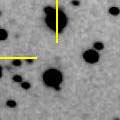
|
New comet. It will reach to 14.5 mag in 2007 summer, but it will be observable only in the Southern Hemisphere at that time. In the Northern Hemisphere, it keeps observable at 17.5 mag in good condition until autumn.
Date(TT) R.A. (2000) Decl. Delta r Elong. m1 Best Time(A, h)
July 1 20 32.90 13 39.1 4.890 5.642 133 18.0 1:58 ( 0, 69)
July 8 20 27.44 13 6.6 4.784 5.595 139 17.9 1:26 ( 0, 68)
|
|
![]()
 C/2003 WT42 ( LINEAR )
C/2003 WT42 ( LINEAR ) 177P/2006 M3 ( Barnard 2 )
177P/2006 M3 ( Barnard 2 ) 102P/Shoemaker 1
102P/Shoemaker 1 117P/Helin-Roman-Alu 1
117P/Helin-Roman-Alu 1 D/1986 W1 ( Lovas 2 )
D/1986 W1 ( Lovas 2 ) C/2005 L3 ( McNaught )
C/2005 L3 ( McNaught ) 2006 HR30
2006 HR30 C/2004 Q2 ( Machholz )
C/2004 Q2 ( Machholz ) 98P/Takamizawa
98P/Takamizawa C/2005 K1 ( Skiff )
C/2005 K1 ( Skiff ) C/2002 VQ94 ( LINEAR )
C/2002 VQ94 ( LINEAR ) C/2005 B1 ( Christensen )
C/2005 B1 ( Christensen ) P/2006 H1 ( McNaught )
P/2006 H1 ( McNaught ) P/2005 L1 ( McNaught )
P/2005 L1 ( McNaught ) P/2005 JY126 ( Catalina )
P/2005 JY126 ( Catalina ) C/2005 S4 ( McNaught )
C/2005 S4 ( McNaught ) C/2006 M1 ( LINEAR )
C/2006 M1 ( LINEAR ) C/2006 K4 ( NEAT )
C/2006 K4 ( NEAT )![]()


















